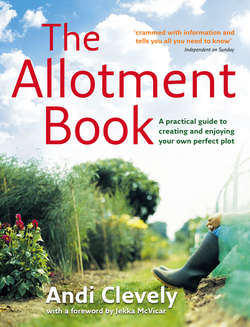Читать книгу The Allotment Book - Andi Clevely - Страница 49
BASIC NECESSITIES
ОглавлениеAlthough allotment tools often seem to multiply over the years, you need only a simple selection of essential tools for most cultivation jobs.
▸ SPADE This is the main digging tool, with a full size or smaller (border) steel blade attached to a shaft of varying length, topped with a plastic or wooden T- or D-shaped handle. Metal shafts are stronger, but less sympathetic in use and they cannot be replaced if they break. For comfort, make sure the blade has a tread on both shoulders, and its neck should be made from a single forged piece of metal.
▸FORK Structurally similar in other respects to a spade, this has tines instead of a blade, and is used for loosening and breaking down soil after digging, and for lifting plants. The tines should be forged from a single piece of steel for maximum strength. Some forks and spades have cranked handles or very long, straight handles for extra leverage.
▸HOE There are two important types of hoe, the main weeding tool. A Dutch, or push, hoe has a flat rectangular blade that is scuffled through the soil as you walk backwards, whereas the draw, or swan-necked, hoe, with its blade at right angles to the handle, is used with a chopping action as you move forwards. Gardeners generally disagree about which kind is the more useful. Other variations are available.
▸ RAKE This is a valuable tool for levelling and refining the soil. The width of the heads and length of the shafts can vary, but the most important quality is the strength of the head and tines, which should be made from forged steel. Check carefully for weight and balance, as it is difficult to manoeuvre a too-heavy rake head.
▸ TROWEL & HAND FORK These key hand tools are used for planting and a host of other operations. The trowel blade and fork tines are of varying shapes and sizes, and are joined to their handles by a straight or cranked neck – test which is easier to wield, check that the handle fits your palm comfortably, and make sure the blade/tines are secured in the handle with a separate ferrule, or metal ring.
▸GARDEN LINE Convenient, but easily replaced by sticks and strong twine.
▸WATERING CAN Essential on plots where hosepipes cannot be used. Metal is more durable than plastic, but it is heavier and may be less comfortable for frequent use. A large can holds about 9 litres (2 gals) and a filled can will weigh around 9 kilos (20lbs), so you may prefer to choose a smaller model. A fine rose (sprinkler head) for seedlings and a coarser one for general watering should cover all needs.
▸GARDENING GLOVES These are invaluable for the messier jobs and for handling prickly and stinging plants. Leather is the strongest material; choose a supple kind for easier manipulation when pruning, for example, and a stronger rigger’s quality for the heaviest tasks.
